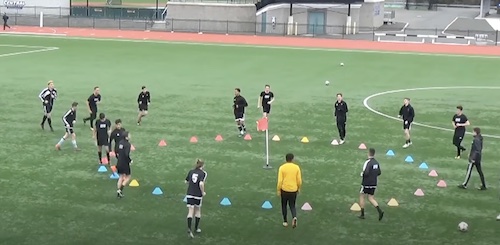Warm up drills in soccer: During warm ups, once your soccer team is relatively warm, stick with basic fundamental soccer drills that also need repetitive practice to stay sharp—tossing the ball to the inside both feet with a partner, balls in a group of three to mix in some running (pass and move, players stationed at the width of the field, one on one side and then two on the other), etc. All of these soccer drills can act as warm up routines prior to moving into a more intense soccer training sessions.
At this point, you can choose to perform a second round of stretches, but this time hold each stretch for a longer amount of time. Under the supervision of a trained professional, you can also move up to dynamic stretching, where you basically stretch while moving. With ballistic movements (usually a bouncing motion) you can achieve greater flexibility. In soccer, that includes leg swings, jumps, high knees, and back kicks (kicking heels up to your butt).
This type of stretching, however, is much more prone to injury if not practiced correctly. Don’t move into dynamic stretching until you’ve completed a basic warm-up and stretching under the direct supervision of a coach or trainer. The last thing you need is to swing your leg up and feel a muscle yank right before a game or practice begins.
A good warm-up will alternate stretching and drills with gradually increasing intensity, and without dead stops in between. Although each player has his/her own preference of how to train and warm up for a game, it’s important to keep your circulation going so that you don’t start playing while cold or stiff. Do whatever you can to avoid losing your momentum right before the game.
SOCCER COACHES: Push your team but leave some energy in the tank for drills later in the practice session or game. Keep an eye on your players and try to get the most out of every minute of practice. You want your team to maintain concentration and focus even in warm up drills. This kind of focus will translate to the games. Watch players so they don’t coast during warm ups or at practice in general—demand the best from them from the beginning to the end of warm-up and practice.
Soccer Warm Up Drills Videos
Think of your body as a car that’s stuck in that dreaded stop-and-go traffic jam. We all know that constant braking can damage the motor and decrease gas efficiency because the car uses more gas and energy to start all over again. It’s much gentler on the car to maintain a steady flow. The same principle applies to your body. The more you stop and go, the more calories your body uses to meet this high impact activity, not to mention the greater physical exertion on your muscles! It’s much more efficient (and safer) to maintain your circulation so that you can be flexible and agile during the game.
The trouble with this, though, is that some players may feel that their routine is too repetitive or limited for their liking. But there are a wide variety of warm-up drills you can perform to maintain your momentum without getting bored. Here’s a quick guide of warm up drills:
- Begin each training session lightly by dribbling the ball in a square and then working on cuts, moves, turns, and feints. Once you warm up your muscles, mix in some sprints to get the blood flowing. This also helps increase the speed of play. Later, perform specific moves the coach instructs you to do. For example, he may ask you to dribble with your left foot only, do the Cruyff cutback move, or take a fake shot. This develops skill work with the ball and improves reaction time.
- Three man weave – Three players stand on a line about 10 feet apart, with the middle player possessing the ball. All three players then run down the field, but the middle player (the passer) lags behind a little and passes the ball to either side, say the right. The passer then runs behind the player on the right and switches sides so that the player on the right now becomes the middle player. Now, the middle player passes to the player on the left and then runs behind him to switch positions. This rotation continues for the length of the playing field and ends with a player kicking the ball into the goal. Note: This is popular among youth teams.
- Man in the middle – Five attackers are arranged in a circle around two defenders. The attackers must keep the ball away from the defenders by playing the ball between each other. The attackers’ goal is to maintain possession of the ball, but if a defender causes an attacker to break the circle, the two must switch places. This drill can be made more difficult by passing the ball between the defenders. Note: Many professional teams use this drill to warm up their passing and possession skills. Sometimes it’s called “piggy in the middle“.
- Soccer tennis – Just like real tennis, the object of this drill is to play the ball between two “teams,” each of which can have between one and four players in any kind of arrangement (e.g. 1vs1, 4vs4, 2vs3, etc.). Set up a barrier to use as a net (either cones, bags, or stepladders with or without connective strings, a real net, etc.) and then play the ball back and forth between sides, never allowing the ball to touch the ground. The idea is to do whatever it takes to keep the ball off the ground, so players can juggle and pass to each other, just as long as the ball crosses the net. This is a great game to improve touch and control, passing in the air, and working with teammates. Check out Tevez, Messi and Maradona playing soccer tennis in this video.
- Small sided game of possession. Setup a small square and play six on six starting off with two or three touches and then moving to one touch. You can also make rules like players have to mark only one player and can’t defend other players or have a group of players outside of the box, along the edges, who have one touch.
- Head Catch Game. Yes, this is a warm up where you use your hands to throw the ball and you can run with the ball until your touched. But you can only score a goal with your head – the ball has to be thrown to a player like a cross for them to head it in the goal. Just a fun way to change things up and get players moving around.
TIP: In soccer tennis, beginners may require several bounces to learn crucial touch skills, so it is best to start playing on a hard surface. For more advanced players, playing on a soft surface such as a grass field will require more juggling because the ball won’t bounce as high.
Here Bayern Munich play keep away or piggy in the middle – in this case 7 versus 2. Watch how fast they move the ball.
And here are some other games and soccer drills that work well as warm up drills:
- One versus one to a cone (earn a goal if you hit the cone with the ball).
- In pairs, each player challenges each other to a juggling face-off. One player calls out a number (e.g. 1, 3, 6) and the opponent must juggle the ball that number of times. Afterwards, the opponent then calls out a number that his challenger must juggle. This is a good exercise to improve juggling and promote quick thinking. It’s also a fun warm up drill — it keeps you on your toes, literally!
- The team forms two lines, about 15 yards apart, and the first player in line passes the ball and then gets in the other line and so on. You can mix it up to make it two passes. The player passes the ball and runs to receive it and lays it off, a long pass and then a short exchange, all one touch. You can also adjust the distance or move this drill into a three player rotation at various lengths.
- Obstacle course – Set up different stations that require players to develop skills in a well-rounded routine. Some ideas are: juggle a certain number of times, dribble through cones, run a few sprints, jump up for headers, perform pushups and sit-ups, and so on. You can increase competitiveness by creating two teams and setting up a race.
- Incorporate a drill where a player has to throw the ball and can only score with a header; each player can only take three steps with the ball and then must pass it. It’s a lively game that gets the team moving around.
The warm-up routine of Barcelona’s Suarez, Neymar and Messi.
Learn more: Aerobic Training & Warm Up Tips & Tricks















